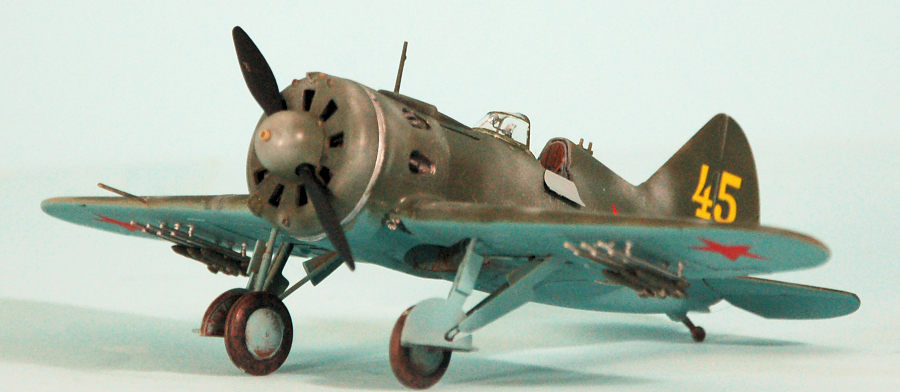
Eduard 1/48 I-16 type 29
| KIT #: | 8152 |
| PRICE: | $25.00 at the time |
| DECALS: | Four options |
| REVIEWER: | Tom Cleaver |
| NOTES: | Profipack |

| HISTORY |
The Polikarpov I-16 is one of the most important aircraft in history. Designed in 1932-33 and first flown on December 30, 1933, it was the first low wing cantilever retractable gear fighter to enter service in May 1934 - at least two years before the Gloster Gladiator biplane!
Nikolai
Nikolaevich Polikarpov began designing an advanced monoplane fighter while he
was in prison for sabotage, working on the Polikarpov I-15 biplane. The design
featured cutting-edge innovations such as retractable landing gear and a fully
enclosed cockpit; in keeping with early 1930s design, it was optimized for speed
with a short-coupled fuselage that gave it a somewhat-similar look to the
American GeeBee racer; it was
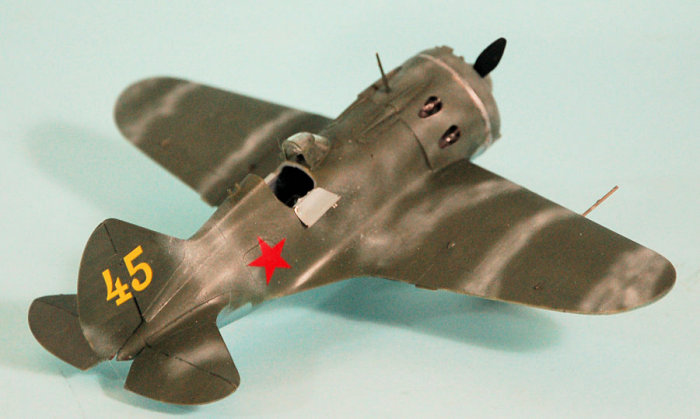 powered by a Wright R-1820 radial engine enclosed
in a modern NACA cowling. The aircraft was small, light and simple to build.
powered by a Wright R-1820 radial engine enclosed
in a modern NACA cowling. The aircraft was small, light and simple to build.
Construction of the TsKB-12 prototype commenced in June 1933, and the aircraft was ordered into production on 22 November 1933, a month before it first flew. The TsKB-12 was of mixed construction, with a wooden monocoque fuselage and wings employing a KhMA chrome-molybdenum steel alloy wing spar, dural ribs and D1 aluminum alloy skinning on the center and leading edges, with the remaining portions of the wings fabric covered. The ailerons were another modern feature, running along almost the entire trailing edge of the wing and also operated as flaps by drooping 15 degrees.
The TsKB-12 was designed for the Wright Cyclone SR-1820-F-3 9-cylinder radial engine (rated at 710 hp). The license for production under the supervision of the Shvetsov design bureau in the Soviet Union was not yet approved, which meant Polikarpov was forced to settle for the less-powerful M-22, the Soviet-built version of the Gnome-Rhone Jupiter 9ASB with 480 hp. The M-22-powered TsKB-12 first flew December 30, 1933 with the famous Soviet test pilot Valery Chkalov at the controls. The second TsKB-12, with a Cyclone engine and three-bladed propeller, flew in January 1934. Initial flight tests in February 1934 revealed very good maneuverability, but the aircraft did not tolerate abrupt control inputs. The TsKB-12 was deemed dangerous to fly and all aerobatics were forbidden. The M-22 version was preferred due to the vibration of the Cyclone-powered aircraft. Wind tunnel testing suggested that the TsKB-12, with its close-coupled tail, would enter an unrecoverable flat spin. Since Cyclone engines were rare, it was decided to risk the M-22 prototype. On March 1-2, 1934, Chkalov performed 75 spins and found the aircraft had very benign stall behavior, dipping a wing and recovering without input from the pilot when airspeed increased; intentional spins could be easily terminated by placing the controls in the neutral position. The stories of vicious spin behavior of the I-16 is unfounded, and in fact the I-153 exhibited much worse spin characteristics.
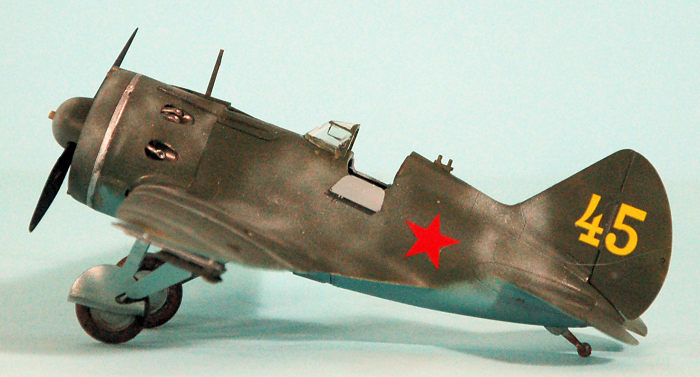 The first
production version was the M-22-powered I-16 Type 4, which entered production in
October 1934 at Factory 21 in Nizhny Novgorod and Factory 39 in Moscow.
The first
production version was the M-22-powered I-16 Type 4, which entered production in
October 1934 at Factory 21 in Nizhny Novgorod and Factory 39 in Moscow.
The Cyclone engine was known as the M-25 when produced in the USSR. The M-25-powered I-16 Type 5, featured a new engine cowling which featured nine forward-facing shuttered openings to control cooling airflow, a redesigned exhaust with eight individual outlet stubs, and other changes. The M-25 was rated at 635 hp at sea level and 700 hp at 7,546 ft. The Type 5 was the world's lightest production fighter at 3,219 lb, as well as the world's fastest, with a top speed of 282 mph at altitude and 245 mph at sea level. The fighter was not good at high-G maneuvering, but had superior speed and climb rates, and extremely responsive aileron control, which gave it a very good roll rate.
Following the outbreak of the Spanish Civil War, I-16s and I-15s were provided to the Spanish Republicans after transfer of the nation’s gold reserves to the USSR. The I-16s flew their first combat mission on November 13, 1936, when 12 I-16s intercepted a Nationalist bombing raid on Madrid. The I-16 was so superior to the He-51 that the Germans were forced to send three prototype Bf-109s and later ten Bf-109As in early 1937 to counter the Soviets. The I-16 picked up the nickname “Boeing” due to the incorrect assumption that it was based on the Boeing P-26. The Nationalists nicknamed it the Rata (Rat), while the Republicans called it Mosca (Fly).
Several
I-16s were lost after structural failure of the wings which was quickly remedied
by reinforced spars. The hot Spanish summers required the addition of oil
radiators, and dust adversely affected the life of the e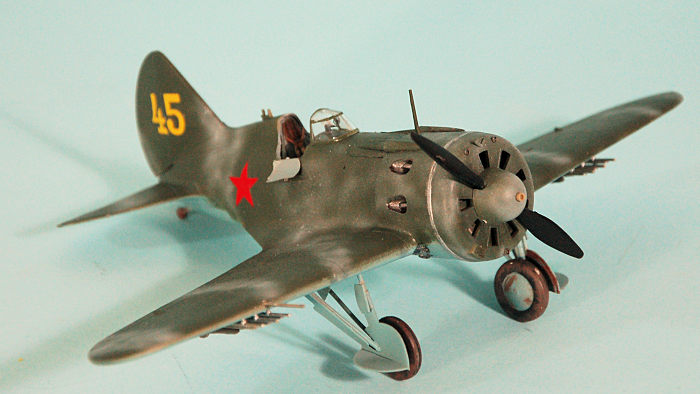 ngines. Although some
aircraft accumulated up to 400 hours of flying time, the average life of an I-16
was 87 days, with maintenance taking 15 days. 276 I-16s were delivered to the
Republicans; 112 were lost in aerial combat, one was shot down by anti-aircraft
fire, 11 were destroyed on the ground, one force-landed and 62 were lost in
accidents.
ngines. Although some
aircraft accumulated up to 400 hours of flying time, the average life of an I-16
was 87 days, with maintenance taking 15 days. 276 I-16s were delivered to the
Republicans; 112 were lost in aerial combat, one was shot down by anti-aircraft
fire, 11 were destroyed on the ground, one force-landed and 62 were lost in
accidents.
250 four-gun I-16 Type 10s were supplied to China in 1937-38. In 1939, 500 I-16s were deployed to the “Nomonhan Incident;” 112 were lost during the battles of Khalkhin Gol, with 88 destroyed in aerial combat against the Nakajima Ki-27.
In 1938,39, further upgrades of weapons included 20mm ShVAK cannons; due to unavailability of the weapons, only a few I-16 Type 12, 17, 27, and 28 were built. The Type 24 replaced the tailskid with a tailwheel and featured the much more powerful 900 hp Shvetsov M-63 engine. The I-16 Type 29 replaced two of the ShKAS guns with a single 12.7 mm UBS machine gun in the lower fuselage. I-16 Types 18, 24, 27, 28, and 29 could carry six RS-82 unguided rockets. The Type 29 was designed as a primary fighter-bomber, without wing armament.
By the time of the German invasion in 1941, the day of the I-16 was long over, but 1,635 of 4,226 V-VS aircraft were I-16s of all variants, fielded by 57 fighter regiments in the frontier areas. By June 24, 1941, of the 1,635 I-16s in service on June 21,only 937 were left. By June 30, there were only 873 left. Of the total 7,005 I-16 fighters delivered, over half were still in service in 1943, when the aircraft was finally removed from frontline service.
| THE KIT |
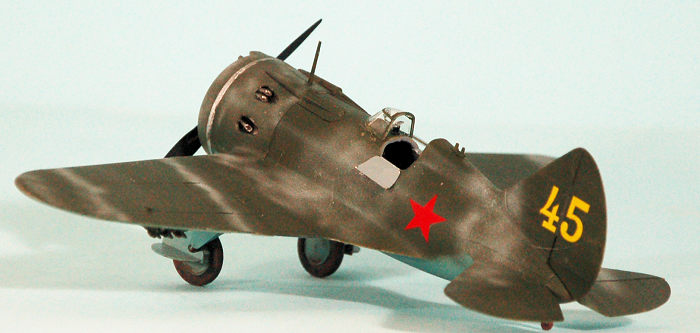 Eduard’s
I-16 series first appeared in 2008. The kit is a marked improvement over the
Hobbycraft I-16, which was the only other mainstream injection-molded I-16 in
1/48. Interestingly, in the 1980s, when Eduard and MPM were the same company and
producing very limited-run vacuform kits of high quality, the I-16 they released
was considered the most accurate model of the type, for anyone who could find a
way to get one through the Iron Curtain.
Eduard’s
I-16 series first appeared in 2008. The kit is a marked improvement over the
Hobbycraft I-16, which was the only other mainstream injection-molded I-16 in
1/48. Interestingly, in the 1980s, when Eduard and MPM were the same company and
producing very limited-run vacuform kits of high quality, the I-16 they released
was considered the most accurate model of the type, for anyone who could find a
way to get one through the Iron Curtain.
The kit suffered criticism from the Usual Suspects on release for its failure to have a curved profile to the upper rear fuselage behind the cockpit.
This Type 29 comes with all three different production versions of forward cowling, and the three different propeller spinners used by I-16s. The exhaust stacks are separate, Surface detail is petite and restrained. The Profipack version includes a photoetch instrument panel and various interior bits, along with a set of seatbelts. The cockpit side panels can be cut away and opened, using photoetch replacements folded open. The I-16 kits have been in production since they were first released and are readily available.
| CONSTRUCTION |
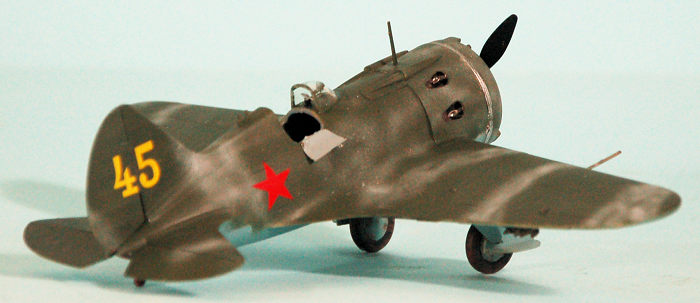 I have to
admit that this kit first sat in the stash after arriving at Le Chateau du Chat
in 2008, and then ended in a box during our move back in 2015, and was only
rediscovered this past winter when I was going through the storage boxes looking
for something else. I opened it up and realized it’s quite a nice kit, and put
it back on the pile to finally create.
I have to
admit that this kit first sat in the stash after arriving at Le Chateau du Chat
in 2008, and then ended in a box during our move back in 2015, and was only
rediscovered this past winter when I was going through the storage boxes looking
for something else. I opened it up and realized it’s quite a nice kit, and put
it back on the pile to finally create.
The kit is simple in construction. I painted the interior a light blue, assembled the simple cockpit, then assembled the wings and mated them to the fuselage. All together, including waiting time for the paint to dry, the model was assembled in an afternoon with no problems. If you take care in test-fitting, there is no need of filler on any of the seams.
| COLORS & MARKINGS |
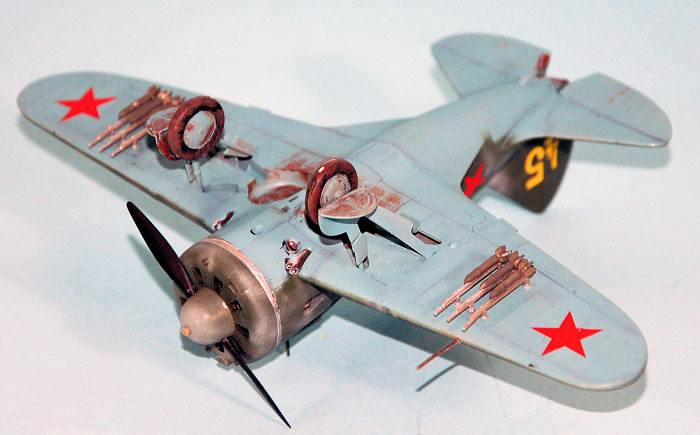 I decided
to do the boxart airplane, an I-16 flown by the 156th IAP during the fighting
for Moscow in the winter of 1941-42.
I decided
to do the boxart airplane, an I-16 flown by the 156th IAP during the fighting
for Moscow in the winter of 1941-42.
I preshaded the panel lines, then applied my own mixture of light blue to the lower surfaces, with Tamiya “NATO Green” used on the upper surfaces. The white winter camo was applied as a thin distemper on the original, and I did my version using Tamiya flat white thinned 60% and “misted on”.
The four red stars and two numbers went on without any problem using Micro-Sol.
I gave the model a coat of thinned clear flat that looked in the end like the weathered wax coat Soviet fighters received at the factory. I then attached the landing gear and rockets, and the windscreen and prop.
| CONCLUSIONS |
In 1/48, the Eduard I-16s are the best kits of this type that are available. One can even get that funny “curved profile” behind the cockpit with a bit of putty and sandpaper if desired. The kit is easy to assemble, and makes up into a nice model. Modelers of any skill level will have no difficulty getting a good result.
14 February 2019
Copyright ModelingMadness.com
Kit courtesy of my billfold.
If you would like your product reviewed fairly and fairly quickly, please contact the editor or see other details in the Note to Contributors.